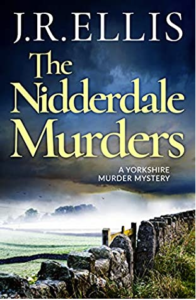It’s been so long since I’ve read a traditional British police procedural that starting this book was just like slipping into a nice hot bath. I mean, I’ve read my fair share of British crime novels with DCI protagonists in the years since I first picked up my dad’s copy of Martha Grimes’ Jerusalem Inn, but lately they’ve been more thriller than cozy-adjacent. Perhaps the most recent traditional was Anne Cleeves’ The Seagull back in 2017, tho The Nidderdale Murders, for someone new to J. R. Ellis’ work, was a much better introduction to the series than Ms Cleeves’ had been to hers.
 The Nidderdale Murders finds DCI Jim Oldroyd called in to the small Yorkshire village of Niddergill to investigate the bizarre shooting death of local landowner Alexander “Sandy” Fraser. A former judge who’d retired to play at gentry and run a grousing moor, Sandy had no shortage of enemies, due in large part to his high-handed manner. When an eye witness sees him shot point blank with a shotgun by Alan Green, a local handyman, it seems like it ought to be an open and shut case. Only Alan had no seeming motive to shoot Sandy, and has since disappeared into thin air.
The Nidderdale Murders finds DCI Jim Oldroyd called in to the small Yorkshire village of Niddergill to investigate the bizarre shooting death of local landowner Alexander “Sandy” Fraser. A former judge who’d retired to play at gentry and run a grousing moor, Sandy had no shortage of enemies, due in large part to his high-handed manner. When an eye witness sees him shot point blank with a shotgun by Alan Green, a local handyman, it seems like it ought to be an open and shut case. Only Alan had no seeming motive to shoot Sandy, and has since disappeared into thin air.
While local police go on the hunt for the missing murderer, DCI Oldroyd begins asking uncomfortable questions of the people who knew Sandy in life. He’s the sort of thorough, thoughtful investigator that is far too rare in policing, fictional or otherwise. It’s refreshing to see him not merely take the word of a single person in order to embark on what could be a fruitless manhunt, but cover all his professional bases. So when a local shopkeeper is murdered by a shotgun at point blank range, again by someone with seemingly no motive who proceeds to vanish, he’s caught less off-guard than a more single-minded, less intellectually curious detective might be.
I actually gasped out loud at the who/howdunnit reveal, so lulled was I by J. R. Ellis’ clever prose. Admittedly, there is something lulling about painstaking police information gathering — the book did feel like it dragged towards the middle as DCI Oldroyd interviewed every single person connected to the case. I also found his Detective Sergeants to be more annoying than interesting after a while, since they seemed to be there only to express admiration for how intelligent their boss was when not serving as middling comic relief. The rest of the cast of characters was pretty interesting tho, quietly defying stereotypes in ways I enjoyed. It’s nice to see so many people cooperative with the police, but I suppose that just indicates the higher level of trust in British policing than American.
This was an above average introduction to the Yorkshire Murder Mysteries, and I know I’ll definitely be turning to this series the next time I want my fix of smart, entertaining police detection in the vein of Colin Dexter’s Inspector Morse series, with the added bonus of some really lovely depictions of the Yorkshire area. Gosh, I miss being able to travel: luckily, this book helped whet my appetite for that, too, if only for a little while.
